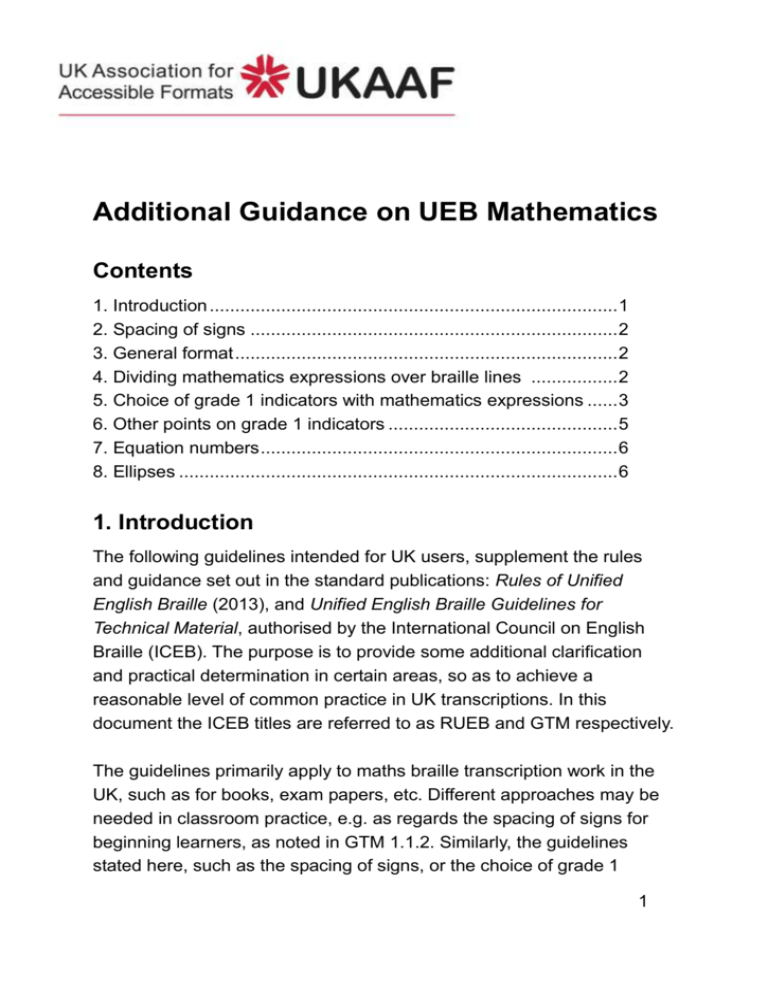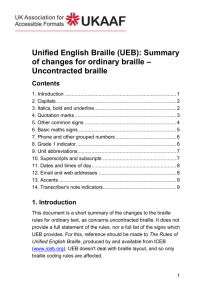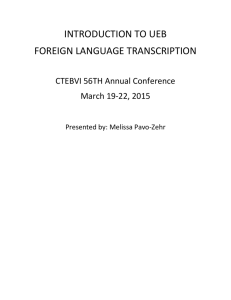UEB Maths guidelines, doc file
advertisement

Additional Guidance on UEB Mathematics
Contents
1. Introduction ................................................................................ 1
2. Spacing of signs ........................................................................ 2
3. General format ........................................................................... 2
4. Dividing mathematics expressions over braille lines ................. 2
5. Choice of grade 1 indicators with mathematics expressions ...... 3
6. Other points on grade 1 indicators ............................................. 5
7. Equation numbers ...................................................................... 6
8. Ellipses ...................................................................................... 6
1. Introduction
The following guidelines intended for UK users, supplement the rules
and guidance set out in the standard publications: Rules of Unified
English Braille (2013), and Unified English Braille Guidelines for
Technical Material, authorised by the International Council on English
Braille (ICEB). The purpose is to provide some additional clarification
and practical determination in certain areas, so as to achieve a
reasonable level of common practice in UK transcriptions. In this
document the ICEB titles are referred to as RUEB and GTM respectively.
The guidelines primarily apply to maths braille transcription work in the
UK, such as for books, exam papers, etc. Different approaches may be
needed in classroom practice, e.g. as regards the spacing of signs for
beginning learners, as noted in GTM 1.1.2. Similarly, the guidelines
stated here, such as the spacing of signs, or the choice of grade 1
1
indicators, would not necessarily be applied in non-mathematical
contexts. (See for example RUEB 11.2.1.)
In this document the word “expression” signifies any group of
mathematical symbols. It may be a single term or a longer group of
mathematical symbols, such as an equation, which is not broken by
ordinary text.
2. Spacing of signs (RUEB 11.2.2; GTM 1.1)
For all levels follow the general rule to leave a space on either side of
comparison or relation signs, but leaving operation signs unspaced from
their adjacent terms.
Example:
6 = 1 2 3 = 1+ 2 + 3
#f "7 #a"8#b"8#c "7 #a"6#b"6#c
3. General format (GTM 1.4.1)
The standard method used in the UK is for set out expressions or
equations to start on a new line in cell 5, with any runovers starting in
cell 7. (This continues the established UK standard practice as given in
Braille Mathematics Notation, BAUK, 2005.)
4. Dividing mathematics expressions over braille
lines (GTM 1.4.1-3)
Splitting an expression before a relation sign or comparison sign rather
than before an operation sign is generally better for conveying the
mathematical meaning. A judgement of the best splitting point in a
particular case may also take into account considerations of saving
space or avoiding an excess of short lines.
2
There is no strict requirement to start a new line in braille where print
starts a new line in set out mathematics (though in some cases it is
worthwhile).
The dot 5 continuation indicator mentioned in GTM 1.4 will not often be
needed: if you make reasonable divisions following the above guidance,
the meaning or format should make it clear enough that the expression
on the new line is a continuation of that on the previous line, e.g. it will
typically start with a relation or operation sign.
5. Choice of grade 1 indicators with mathematics
expressions (RUEB 5.9; GTM 1.7)
The UEB rules allow different approaches to the use of grade 1
indicators. As explained in the introduction, the purpose of the following
is to set out a standardised method, though it does not invalidate other
approaches:
There will often be cases where no grade 1 indicators are required in a
maths expression, however if grade 1 indicators are required then the
basic principle to follow is:
Unless it is sufficient to just use one instance of a grade 1 symbol
indicator
(a) within the first 3 cells of a maths expression, and/or
(b) before a single letter standing alone anywhere in the
expression,
then use a word indicator for expressions without braille spaces, or
passage indicators for expressions with braille spaces.
Note that the end of a braille line counts as a braille space in the case of
expressions divided over more than one line, unless the dot 5
3
continuation sign is used. Also, “standing alone” is meant according to
the standard UEB definition in RUEB 2.6, and includes various cases
where a letter adjoins brackets or punctuation.
Examples:
x"6y "7 #f
x+ y=6
(no grade 1 indicators needed)
x;9#b"6y9#b "7 ;,c
x2 + y 2 = C
(grade 1 indicator only in first 3 cells and before a letter standing alone)
a c
;;(a./b)"6(c./d)
+
b d
(unspaced expression, grade 1 word indicator needed)
a n a m = a n+m
;;;a9n"8a9m "7 a9<n"6m>;'
(spaced expression, grade 1 passage indicator needed)
The result of this principle is to largely avoid grade 1 indicators within
maths expressions. Of course there are cases where a grade 1 indicator
is essential at a particular point, notably where a letter a-j immediately
follows a number (so that it is not read as a digit): the above rule does
not apply to such cases where there is no option.
In addition, note the following:
(a) Units: Where a unit is part of a longer expression then treat it as
belonging to the longer expression in the application of the above rule.
But where a unit is standing alone or just accompanies a number, treat
each spaced element of the unit as a separate expression, each
following the above rule.
Examples:
25 km 2
#be km;9#b
4
6 m s 1
#f ;m ;;s9<"-#a>
(b) Where a maths expression involves words it may be best to use a
grade 1 symbol or word indicator where needed within the expression,
rather than grade 1 passage mode for the whole expression, as it allows
the use of contractions in the words.
Example:
C = {integers less than N 2 }
;,c "7 _<9teg]s less ?an ,n;9#b_>
(c) Matrices often take up a lot of space in braille and there will be
occasions where using a grade 1 symbol indicator within such an
expression will be preferable to using grade 1 passage indicators.
Experienced transcribers may find and apply other reasonable special
cases like (b) and (c), and it is accepted that there may be some
variation in choices made as a consequence. But the main point is to
keep the above basic principle as the central idea.
Note that examples in GTM do not necessarily illustrate the same choice
of grade 1 indicators as set out here (so don't be unduly concerned or
confused by this!), but the meaning of the braille is the same.
6. Other points on grade 1 indicators
Where grade 1 passage indicators are used around a maths expression,
punctuation at the end of the expression (e.g. a sentence full stop)
should normally be included before the grade 1 terminator, even though
not part of the expression itself.
Example:
x + y = z = t 2.
;;;x"6y "7 z "7 t9#b4;'
5
If there is more than one separate maths expression (e.g. several
equations), following one after the other, for which grade 1 passage
indicators would be used, then the whole group can be enclosed in
passage indicators rather than using separate indicators for each.
Intervening punctuation would be included within the passage indicators,
but in general not words. In the latter case you would normally close the
passage before the words, and restart passage mode (if needed) at the
beginning of the next maths expression.
Note that a grade 1 passage continues onto a new braille page until the
passage terminator, so if an expression is split over braille pages you do
not need to restart the passage on the new page.
7. Equation numbers
Equation numbers should be placed before the equation in braille, and
be separated from it by a single space, even if they appear on the right
in print.
8. Ellipses
Where print uses a large number of dots for an ellipsis without special
reason, as in expressions for series or sets, for neatness only use 3
unspaced stops. This is despite RUEB 7.3.1.
[February 2015]
6
UKAAF contact details
UKAAF
PO Box 127
Cwmbrân
NP44 9BQ
Tel: 0845 60 85223
Fax: 0845 60 85224
Email: enquiries@ukaaf.org
Web: www.ukaaf.org
UKAAF registered address
UKAAF
c/o Pia
Victoria Street
Cwmbrân
NP44 3YT
President: Lord Low of Dalston CBE
Registered charity number: 1126966
Registered as a company in England and Wales number: 6748900
7






